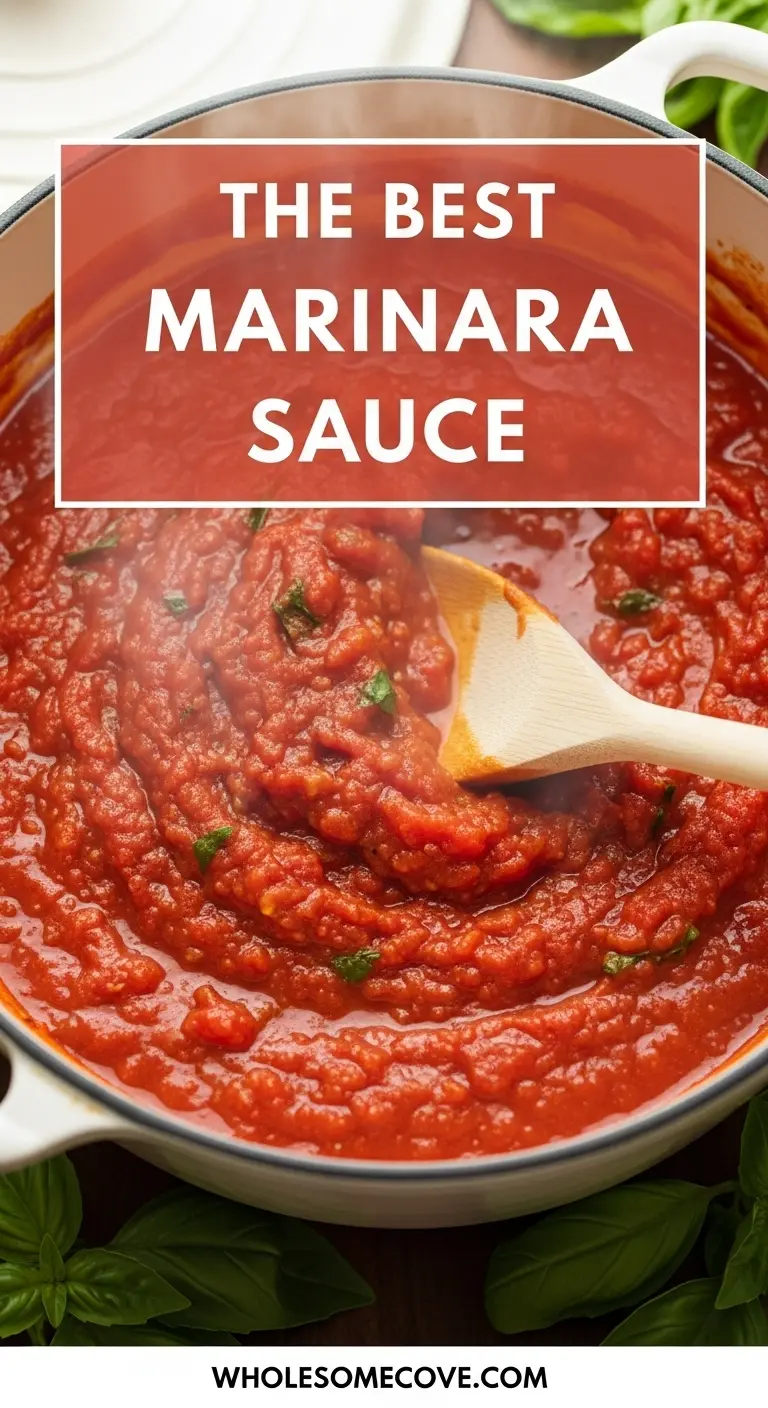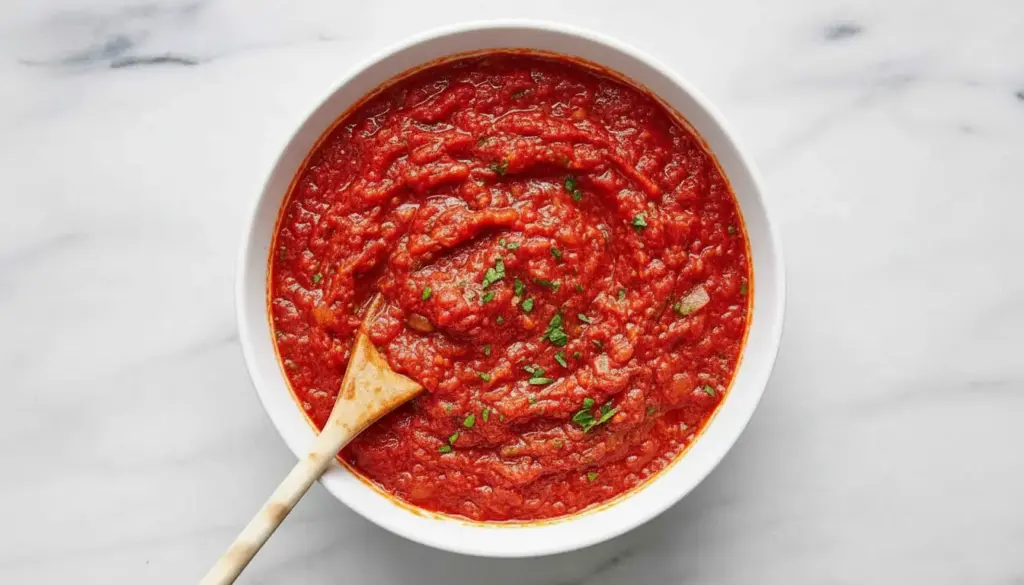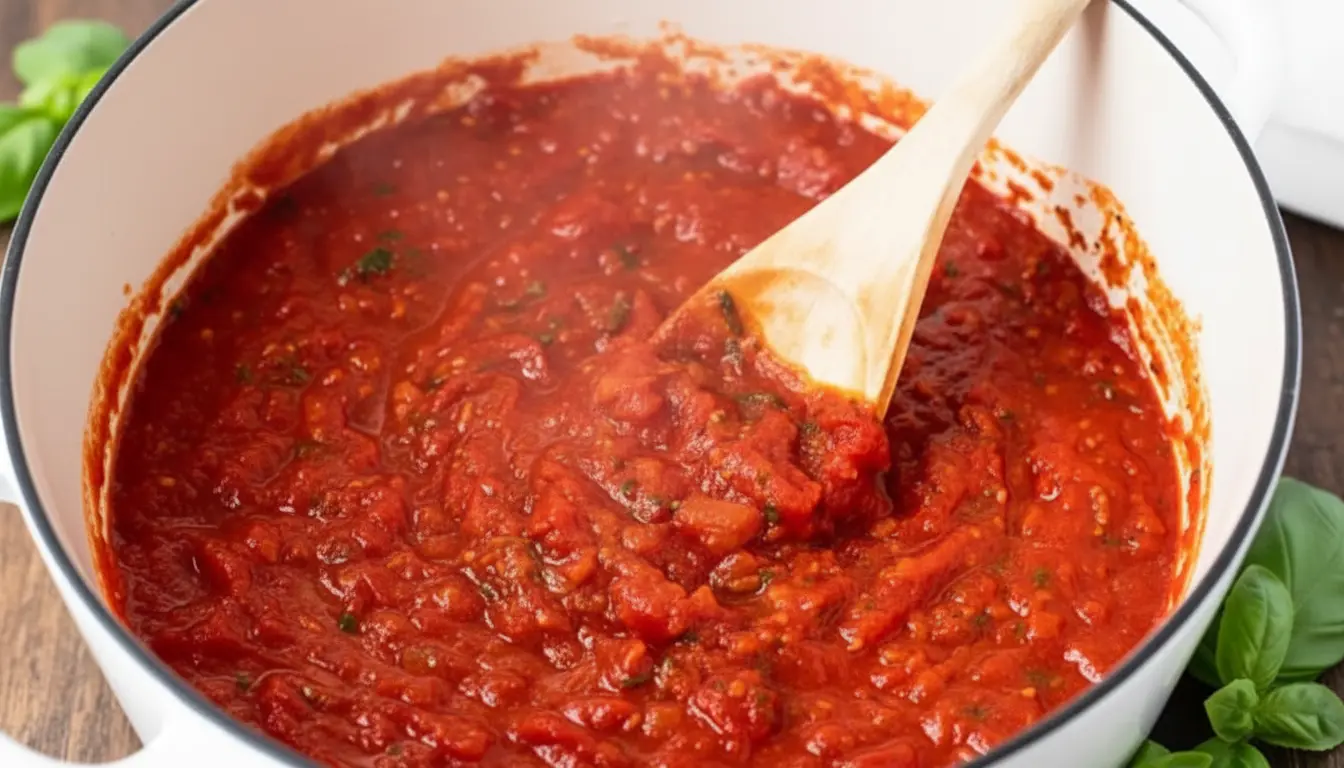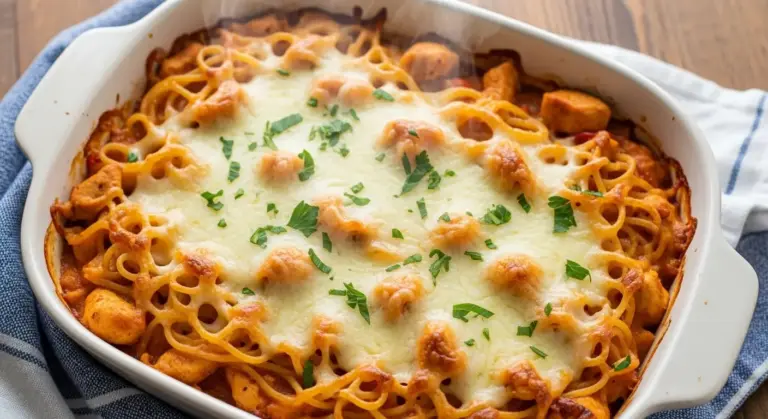Making your own marinara sauce from scratch changed everything about how I cook Italian food at home. I used to grab jars from the grocery store without thinking twice, until one evening when I opened my pantry and realized I’d run out.
With a pot of pasta water already boiling and hungry kids asking when dinner would be ready, I started throwing together what I had on hand: canned tomatoes, garlic, olive oil, and herbs from my windowsill garden.
That impromptu creation turned out better than any store-bought version I’d ever tried. The flavors were brighter, the texture was silkier, and I could actually taste each ingredient. Now, I make this marinara sauce recipe at least twice a month, and I always keep the ingredients stocked because it’s become my go-to base for so many meals.
The best part? It takes less time than you’d think, and once you get the technique down, you can customize it endlessly based on what’s in your kitchen.
| Quick Recipe Summary | |
|---|---|
| Prep Time | 10 minutes |
| Cook Time | 35 minutes |
| Total Time | 45 minutes |
| Servings | 6 cups (about 6-8 servings) |
| Difficulty Level | Easy |

Why You’ll Love This Marinara Sauce Recipe
This sauce has become my kitchen MVP because it works for everything from a quick weeknight spaghetti dinner to a base for more complex dishes. I’ve used it in lasagnas, baked ziti, chicken parmesan, and even as a pizza sauce.
The simplicity is what makes it so versatile. You’re not locked into complicated steps or hard-to-find ingredients, which means you can whip this up whenever the craving hits.
Here’s why this marinara sauce stands out:
- Fresh, vibrant flavor: Unlike jarred sauces that can taste flat or overly sweet, this version lets the tomatoes shine with just the right balance of garlic, herbs, and olive oil
- Quick cooking time: Ready in under an hour, which is faster than many slow-simmered recipes but still develops deep flavor
- Pantry-friendly ingredients: Everything you need is probably already in your kitchen
- Easily customizable: Add red pepper flakes for heat, fresh basil for brightness, or a splash of red wine for depth
- Freezer-friendly: Make a double batch and freeze portions for those nights when cooking feels impossible
- Budget-conscious: Costs a fraction of premium jarred sauces and tastes infinitely better
You might also enjoy: Creamy Tomato Basil Soup Recipe
Ingredients
This marinara sauce comes together with simple ingredients that you likely have on hand. I’ve learned that quality matters here, especially with the tomatoes and olive oil, since they’re the stars of the show.
- 3 tablespoons extra virgin olive oil (45ml) – Use good quality olive oil since it forms the flavor base
- 6 cloves garlic, minced (about 2 tablespoons)
- 1 small onion, finely diced (about 1 cup / 150g)
- 2 cans (28 oz / 794g each) whole peeled San Marzano tomatoes – San Marzano tomatoes are worth seeking out for their sweet, low-acid flavor
- 2 tablespoons tomato paste (30g) – Adds depth and richness
- 1 teaspoon dried oregano (2g)
- 1 teaspoon dried basil (2g)
- ½ teaspoon salt (3g), plus more to taste
- ¼ teaspoon black pepper (0.5g)
- ¼ teaspoon red pepper flakes (0.5g) – Optional, for a gentle heat
- 1 teaspoon sugar (4g) – Balances the acidity of the tomatoes
- ¼ cup fresh basil leaves (10g), torn – Added at the end for bright, fresh flavor
- 2 tablespoons butter (28g) – Optional but recommended for silky texture
Kitchen Equipment Needed
Having the right tools makes the cooking process smoother, though you don’t need anything fancy for this sauce.
- Large heavy-bottomed saucepan or Dutch oven (4-5 quarts / 4-5 liters) – The heavy bottom prevents scorching and distributes heat evenly
- Wooden spoon – For stirring without scratching your pot
- Sharp knife and cutting board – For prepping garlic and onions
- Can opener – For the tomato cans
- Immersion blender or potato masher – To break down the tomatoes to your desired consistency
- Measuring spoons and cups
- Ladle – For serving
- Storage containers or jars – For storing leftovers
Read Also: Easy Alfredo Sauce Recipe
Recommended Products for This Recipe
After making this sauce countless times, I’ve found a few products that genuinely elevate the final result and make the cooking process easier.
1. Cento San Marzano Certified Peeled Tomatoes
These are the tomatoes I reach for every single time. San Marzano tomatoes grown in the volcanic soil near Mount Vesuvius have a naturally sweet flavor and lower acidity that makes them perfect for marinara. The Cento brand is reliably good and actually certified DOP, which means they’re the real deal from Italy.
2. Le Creuset Enameled Cast Iron Dutch Oven
I saved up for this Dutch oven years ago, and it’s been worth every penny. The heavy construction means the sauce cooks evenly without hot spots that can scorch your tomatoes. The enameled interior doesn’t react with acidic tomatoes, and cleanup is surprisingly easy. It’s also beautiful enough to go from stove to table.
3. KitchenAid Immersion Blender
This tool has changed how I make marinara. Instead of transferring hot sauce to a blender (which always feels dangerous), I can blend it right in the pot to whatever consistency I want. The variable speed control means you can go from slightly chunky to silky smooth. I use mine for soups, smoothies, and sauces at least twice a week.
4. California Olive Ranch Extra Virgin Olive Oil
Since olive oil is one of the main flavors in marinara, quality matters. This California-made oil is fruity and peppery without being bitter. It’s also more affordable than imported Italian oils while still delivering great flavor. I keep this on hand for all my cooking.
Another favorite: Healthy Alfredo Sauce Recipe

Step-by-Step Instructions: How to Make Marinara Sauce
I’ll walk you through each step of making this sauce so it turns out perfectly every time. The process is straightforward, but paying attention to a few key moments makes all the difference.
1. Sauté the Aromatics
- Heat the olive oil in your Dutch oven or large saucepan over medium heat until it shimmers but doesn’t smoke (about 2 minutes).
- Add the diced onion and cook, stirring occasionally, until it becomes soft and translucent (about 5-6 minutes). You want the onion to release its sweetness but not brown.
- Add the minced garlic and cook for 1 minute, stirring constantly so it doesn’t burn. The garlic should smell fragrant but not turn brown, which would make it bitter.
- Stir in the tomato paste and cook for 2 minutes, stirring frequently. This step caramelizes the tomato paste slightly, which adds a deeper, richer flavor to your sauce.
2. Add the Tomatoes
- Pour in both cans of whole peeled tomatoes along with their juices. Don’t drain them – that liquid is full of tomato flavor.
- Use your wooden spoon to break up the whole tomatoes against the side of the pot, or use your hands to crush them before adding (my preferred method when I’m not worried about making a mess).
- Bring the mixture to a simmer over medium-high heat, which should take about 5 minutes.
3. Season and Simmer
- Once simmering, reduce the heat to medium-low so the sauce maintains a gentle bubble.
- Add the dried oregano, dried basil, salt, black pepper, red pepper flakes (if using), and sugar. Stir well to combine.
- Let the sauce simmer uncovered for 25-30 minutes, stirring every 5-7 minutes to prevent sticking. The sauce will thicken and reduce, and the flavors will concentrate beautifully.
- If the sauce looks too thick or starts sticking to the bottom, reduce the heat slightly and add a splash of water (about ¼ cup / 60ml at a time).
4. Blend to Desired Consistency
- After simmering, decide on your preferred texture. I like mine somewhere between chunky and smooth – what I call “rustic.”
- For a chunky sauce, use a potato masher to break down the tomatoes to your liking.
- For a smoother sauce, use an immersion blender directly in the pot. Pulse it a few times for a slightly textured sauce, or blend continuously for 30-60 seconds for a completely smooth consistency.
- If you don’t have an immersion blender, carefully transfer the hot sauce in batches to a regular blender, leaving the lid slightly ajar to let steam escape.
5. Finish the Sauce
- Stir in the butter (if using) until it melts completely. This adds a luxurious, velvety texture that rounds out the acidity.
- Taste and adjust seasoning. You might want more salt, a pinch more sugar if it tastes too acidic, or extra red pepper flakes for heat.
- Turn off the heat and stir in the fresh basil leaves. They’ll wilt from the residual heat and release their aromatic oils.
- Let the sauce rest for 5 minutes before serving. This allows the flavors to settle and marry together.
This pairs beautifully with my Velveeta Mac and Cheese Recipe for a fun twist on Italian-American comfort food.
Tips for The Best Marinara Sauce
Through trial and error (and a few batches that didn’t quite hit the mark), I’ve learned some tricks that consistently produce better sauce.
- Use San Marzano tomatoes when possible: The flavor difference is noticeable. They’re sweeter and less acidic than regular canned tomatoes, which means your sauce tastes more balanced.
- Don’t rush the garlic: Burnt garlic tastes acrid and bitter. Keep the heat at medium and watch it closely during that one-minute cooking time.
- Simmer, don’t boil: A vigorous boil can make your sauce taste harsh and separate the oil from the tomatoes. Keep it at a gentle simmer.
- Taste as you go: Tomatoes vary in acidity, so you might need more or less sugar depending on your batch. Start with the recipe amounts and adjust.
- Add butter for restaurant-quality richness: This was a trick I learned from a chef friend. Just a couple tablespoons makes the sauce taste more luxurious without being heavy.
- Save some pasta water: If you’re serving this immediately over pasta, reserve a cup of the starchy cooking water before draining. A few splashes help the sauce cling to the noodles.
- Let it rest: Giving the sauce 5-10 minutes off the heat before serving allows the flavors to come together. It’s tempting to dive right in, but this brief rest makes a difference.
- Use fresh basil at the end: Adding fresh herbs at the very end preserves their bright, aromatic flavor. Cooking them too long makes them taste dull.
- Store properly: Let the sauce cool completely before refrigerating or freezing. Hot sauce going into containers creates condensation that can affect the texture.
Serving Suggestions

This marinara sauce is incredibly versatile, which is one of the reasons I make it so often. Here’s how I typically use it:
One of the most obvious but satisfying ways to enjoy this sauce is over freshly cooked pasta. Toss it with spaghetti, penne, rigatoni, or any shape you love. I like to add a generous handful of freshly grated Parmesan cheese and a drizzle of good olive oil on top.
Use it as a pizza sauce spread thinly over your dough before adding cheese and toppings. The concentrated flavors work perfectly here, and you’ll never want to buy pizza sauce again.
Layer it in lasagna, baked ziti, or any pasta bake. The sauce holds up beautifully to baking and adds moisture to these casserole-style dishes.
Serve it as a dipping sauce for:
- Healthy Bruschetta – the perfect match
- Mozzarella sticks or fried cheese
- Garlic bread or breadsticks
- Meatballs or sausages
Use it as a base for other dishes:
- Chicken parmesan or eggplant parmesan
- Shakshuka (poach eggs directly in the simmering sauce)
- Best Sausage Tortellini Soup – add broth and tortellini
- Marry Me Chicken Pasta – use it as the tomato component
Pair it with these sides for a complete Italian meal:
- Roasted Brussels Sprouts with Bacon
- Grilled Vegetable Skewers
- Healthy Cornbread
- Simple green salad with lemon vinaigrette
Variations of Marinara Sauce
Once you’ve mastered the basic version, you can experiment with different flavors and ingredients to keep things interesting.
Here are my favorite variations:
- Arrabbiata sauce: Double or triple the red pepper flakes and add an extra clove of garlic for a spicier version. The name means “angry” in Italian, and the heat definitely has a kick.
- Vodka sauce: After the sauce is done, stir in ½ cup (120ml) of vodka and ¼ cup (60ml) of heavy cream. The vodka enhances the tomato flavor, and the cream makes it luxuriously smooth.
- Puttanesca: Add 2 tablespoons of capers, ½ cup (80g) of sliced Kalamata olives, and 4 anchovy fillets (minced) when you add the tomatoes. This creates a briny, bold sauce that’s packed with umami.
- Mushroom marinara: Sauté 8 ounces (225g) of sliced mushrooms with the onions until they’re golden brown. This adds an earthy, meaty quality that makes the sauce more substantial.
- Red wine marinara: Replace ½ cup (120ml) of the tomato juice with dry red wine. Add it after the garlic and let it cook for 2-3 minutes before adding the tomatoes.
- Fresh tomato version: In summer when tomatoes are at their peak, substitute 3 pounds (1.4kg) of fresh, ripe tomatoes (peeled and chopped) for the canned tomatoes. You’ll need to simmer it a bit longer to concentrate the flavors.
- Roasted garlic marinara: Use a whole head of roasted garlic instead of raw garlic. Squeeze the soft cloves out of their skins and mash them into the sauce. The flavor is sweeter and more mellow.
- Herb-loaded version: Add fresh thyme, rosemary, or a bay leaf during simmering. Just remember to remove the bay leaf before serving.
Storage and Reheating
Proper storage is key to keeping this sauce fresh and delicious for future meals. I almost always make extra because having homemade marinara on hand feels like a secret weapon for quick dinners.
Refrigerator storage:
- Let the sauce cool completely to room temperature before storing (about 30-45 minutes).
- Transfer to airtight containers or jars, leaving about ½ inch (1.3cm) of space at the top.
- Store in the refrigerator for up to 5-7 days.
- Pour a thin layer of olive oil on top before sealing to help preserve freshness.
Freezer storage:
- Cool the sauce completely, just like for refrigerator storage.
- Pour into freezer-safe containers, leaving 1 inch (2.5cm) of headspace for expansion.
- Alternatively, freeze in ice cube trays or muffin tins, then transfer the frozen portions to freezer bags. This method gives you perfect single-serving amounts.
- Label with the date and contents – it’ll stay good for up to 3-4 months.
- Thaw overnight in the refrigerator before reheating.
Reheating instructions:
- Stovetop (preferred method): Pour the sauce into a saucepan and heat over medium-low heat, stirring occasionally, until warmed through (about 5-7 minutes). Add a splash of water or olive oil if it seems too thick.
- Microwave: Place in a microwave-safe bowl, cover loosely, and heat in 1-minute intervals, stirring between each interval, until hot.
- From frozen: You can reheat frozen sauce directly on the stovetop over low heat. Add a bit of water to prevent sticking and break it up with a spoon as it thaws.
For a lighter option, try: Zucchini Noodles with Pesto and Shrimp Bowls Recipe
Nutritional Facts
Here’s the approximate nutritional information per serving (based on 8 servings, about ¾ cup / 180ml each):
- Calories: 95
- Total Fat: 6g
- Saturated Fat: 2g
- Trans Fat: 0g
- Cholesterol: 8mg
- Sodium: 380mg
- Total Carbohydrates: 10g
- Dietary Fiber: 3g
- Sugars: 6g
- Protein: 2g
- Vitamin A: 15% DV
- Vitamin C: 20% DV
- Calcium: 4% DV
- Iron: 8% DV
Note: These values are estimates and will vary based on specific brands of ingredients used, especially the tomatoes and whether you include optional ingredients like butter.
Health Benefits of Key Ingredients
Beyond just tasting amazing, this marinara sauce is actually packed with nutrients that make it a smart choice for regular meals.
Tomatoes are the nutritional stars here. They’re loaded with lycopene, a powerful antioxidant that becomes even more bioavailable when tomatoes are cooked. Lycopene has been linked to reduced risk of heart disease and certain cancers. Tomatoes also provide vitamin C, potassium, and vitamin K.
Garlic is well-known for its immune-boosting properties. It contains compounds like allicin that have antibacterial and antiviral effects. Regular garlic consumption has been associated with lower blood pressure and improved cholesterol levels.
Olive oil provides heart-healthy monounsaturated fats and anti-inflammatory compounds. Extra virgin olive oil also contains polyphenols that act as antioxidants in the body.
Basil isn’t just aromatic – it’s packed with vitamin K, which is essential for blood clotting and bone health. It also contains antioxidants and anti-inflammatory compounds.
Onions add more than just flavor. They’re a good source of vitamin C, B vitamins, and fiber. They also contain quercetin, an antioxidant that may help reduce inflammation.
The beauty of homemade marinara is that you control the sodium content (much lower than most jarred sauces), there are no added preservatives or artificial ingredients, and you can adjust the fat content based on your needs.
Read Also: Healthy Pumpkin Pie Recipe
FAQs About Marinara Sauce
1. Can I use crushed tomatoes instead of whole tomatoes?
Absolutely. Crushed tomatoes work great and will give you a slightly thicker, more uniform texture from the start. You might not need to blend the sauce at all if you prefer a chunkier style. The flavor will be just as good, though I personally prefer the control that comes with starting with whole tomatoes and breaking them down myself.
2. Why does my marinara sauce taste too acidic?
Tomato acidity varies by brand and harvest season. If your sauce tastes too acidic, add sugar ¼ teaspoon at a time until it balances out – I’ve sometimes needed up to 2 teaspoons total. The butter also helps mellow acidity, as does a longer simmer time, which concentrates and sweetens the tomatoes naturally.
3. Can I make this sauce in advance?
Yes, and I actually recommend it. Marinara sauce often tastes even better the next day after the flavors have had time to meld together. Make it up to 3 days ahead and store it in the refrigerator. You can also freeze it for up to 3 months, which I do regularly so I always have some on hand.
4. What’s the difference between marinara and spaghetti sauce?
Marinara is typically a simpler sauce with fewer ingredients – tomatoes, garlic, olive oil, and herbs. Spaghetti sauce is often more complex and may include meat, mushrooms, bell peppers, or additional vegetables. Marinara cooks faster and has a brighter, fresher flavor, while spaghetti sauce is usually simmered longer for a deeper, more complex taste.
5. My sauce is too watery – how do I fix it?
Continue simmering it uncovered over medium-low heat, stirring occasionally, until it reaches your desired thickness. This can take an additional 10-15 minutes depending on how watery it is. You can also stir in an extra tablespoon of tomato paste to thicken it more quickly. Next time, make sure you’re maintaining a proper simmer rather than just a gentle heat, which will help evaporate liquid faster.
Final Thoughts
This marinara sauce has become such a staple in my kitchen that I honestly can’t imagine going back to store-bought versions. There’s something deeply satisfying about making your own sauce from scratch, especially when it’s this straightforward and forgiving.
I hope this recipe becomes a regular in your rotation too. Once you taste the difference that fresh ingredients and a little time can make, you’ll understand why I keep coming back to it week after week. Try it with your favorite pasta, slather it on homemade pizza, or use it as a jumping-off point for more complex dishes.
I’d love to hear how your marinara turns out. Drop a comment below and let me know what you served it with, or share any variations you tried. And if you loved this recipe, please share it with friends who appreciate good, simple food made from scratch.
Recommended:
- Pumpkin Sage Pasta Recipe
- Butternut Squash Gnocchi Recipe
- Air Fryer Lasagna Recipe
- Eggplant Parmesan with Zucchini Recipe
- Healthy Chicken Parmesan Recipe
- Olive Garden Alfredo Sauce Recipe
- Baked Chicken with Alfredo Sauce Recipe
- Tomato Basil Mozzarella Flatbread Pizza Recipe
- Healthy Pizza Dough Recipe
- Chicken Caprese Skillet Recipe




